Welcome Spring and some wonderful daffodils
Friday, March 28, 2014
At last it is good to be able to report more stable weather this
month with a spell 12 dry days mid month, and some warm sunshine.
Wet and windy at times but not excessively so. The sunshine and
particularly the increased light levels brought a surge of growth
all over the gardens, none better than the daffodils which have
rarely looked better.
Division 6 Group Narcissus are personal favourites and
"Trena" is one of the best
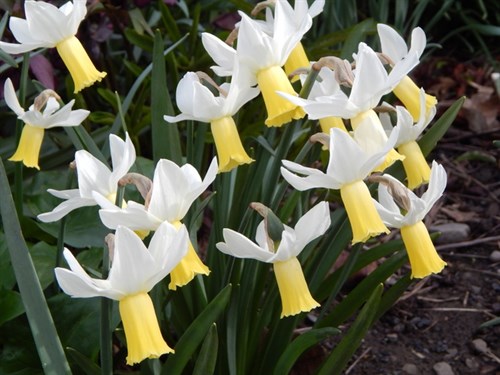
This time last year I was despairing at their poor showing and
wondering if some of the more established clumps were past their
best. The display this year suggests those fears were premature.
There could be several reasons for the improved showing: they had a
"rest" last spring, they were deadheaded after flowering as always,
the warm weather last summer helped to ripen the bulbs, the copious
rain and lack of penetrating frosts during the winter may also have
played a part. But perhaps the biggest factor was the feed of fish,
blood and bone I scattered around the bulbs after flowering last
April. I shall return to daffodils later.
You may be wondering why I have mentioned snowmen in the heading
as we have had none of the white stuff this month. We had the
warning of a short cold snap over the weekend of 22nd and 23rd and
right on cue we had an overninght minimum of -4C in the early hours
of 24th, enough to potentially damage the tender new growth of many
shrubs, particularly hydrangeas which were very forward, so out
came all the horticultural fleece (I have miles!! of it) and
covered all the shrubs most at risk. When I went round the gardens
next morning the clumps of fleece covering shrubs looked just like
an army of snowmen!
Just a small corner of snowmen - plenty more
around the corner!
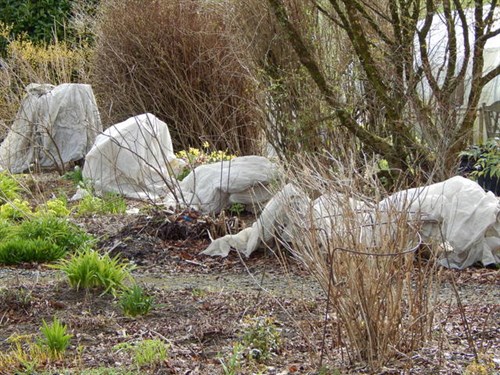
Thanks to the long spell of fine weather I was at last able to
completely restore the small poytunnel damaged in the gales over
the Christmas period. Without it I have been like "little boy lost"
as at propagation time I spend most of my time there. More of this
later.
Getting the interior back into working order took
nearly as long as rebuiding the tunnel.
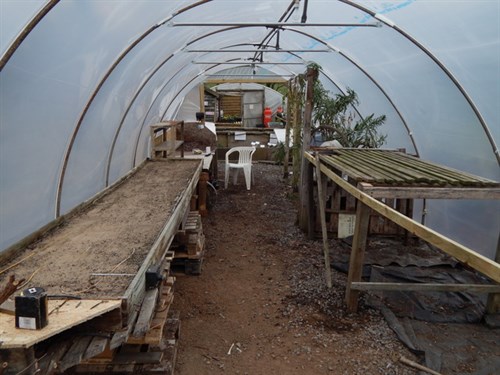
Weather
As already mentioned a good month, rather typical of a
traditional March -4 seasons in one month.. Most years we seem to
have at least one dry settled spell often with warm sunshine. This
year the max was 16.5C, warm enough to take the jumper off for the
first time, and 10 other days over 12C.There were 7 frosty nights,
quite a contrast to last March when there 16 with a minimum of -9C
and a predominantly easterly air stream . Exactly 38 years ago when
I moved into Cilgwyn Lodge we had a very mild March when the fields
around us were quite bare because of the lack of rain. This was
followed by the incredible summer of 1976 and caused my neighbour
Meirion to caution me that this was Wales and not all years would
be like this and how right he was!
Garden update
The main highlight for me has been completion of the extensive
repairs to the poytunnel which took far longer than expected (12
days as opposed to 3-4 days). I took the tunnel back to bare hoops
and started again, reinforcing them with crop bars and stays and
constructing stronger door frames. The original tunnel is a very
early form with hoops that create a half cicle and no straight
sides which is the current preferred shape. The hoops are also
smaller in diameter than modern tunnels so I had to make
adjustments to allow modern parts to be fitted. I obtained all the
materials from First Tunnels, a company I had previously used when
building my second tunnel. They were exceptionally helpful and made
parts to fit my old tunnel. I cannot recommend them enough to
anyone thinking of erecting a new tunnel or refurbishing an old
one. One particularly helpful recent introduction to save digging a
deep trench in which to bury the polythene to provide rigidity and
a tight skin, is an aluminium base rail initially 7 cms above
ground floor level. This is clamped to the hoops and when the
polythene is fixed to the rail it can then be lowered and tightened
to create an incredibly tight skin. I have my refuge back at last
and in just a few days it is beginning to fill up again. We are
very grateful to our friends Robert and Barry for all their help
with the rebuilding
The rebuilding from start to finish
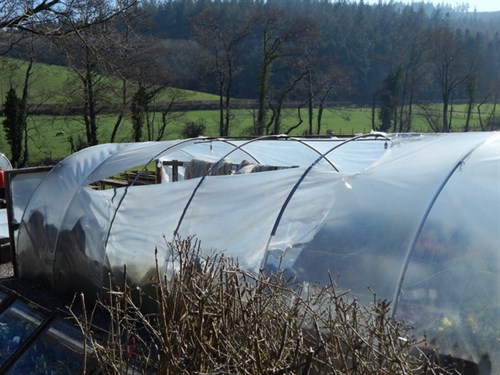
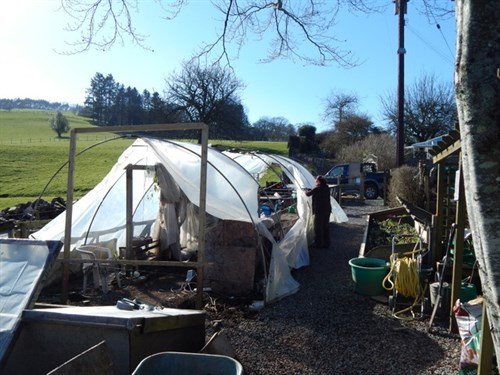
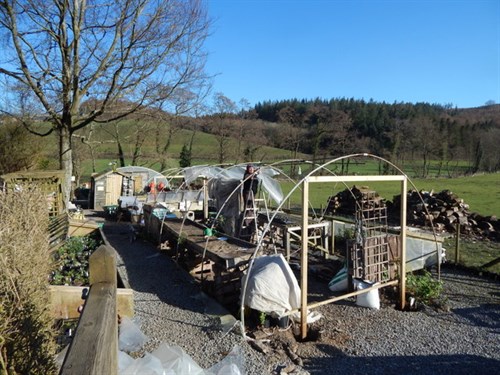
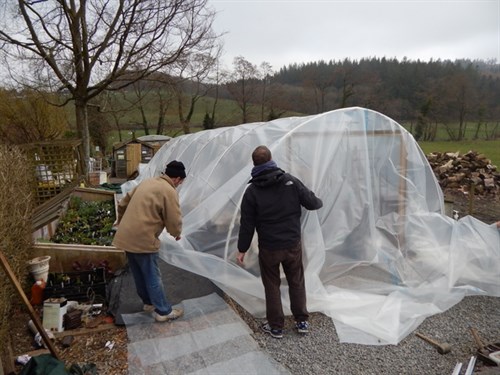
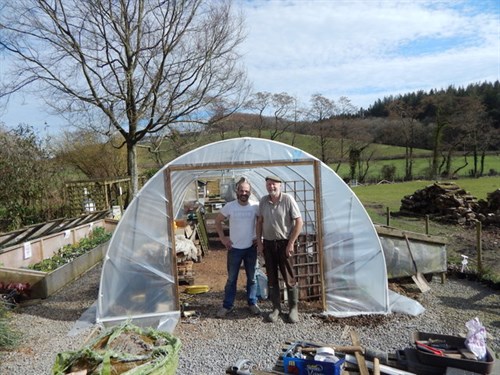
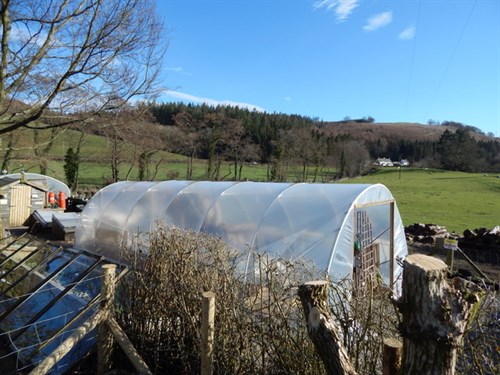
And at twilight just after we finished
there was a perfect full moon
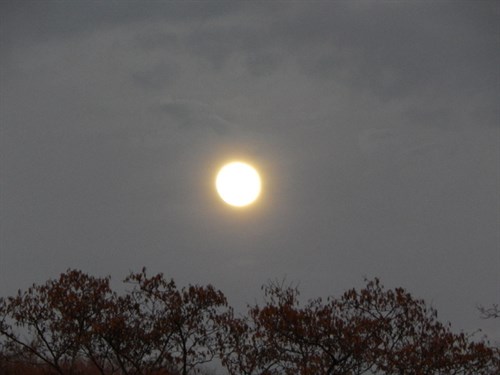
I have been limited in what work I could do elsewhere in the
garden but I have been able to do most of the initial border
weeding which is a key task for March - a race against time before
the bittercress sets seed. The lawns are green and growing strongly
so have been mowed twice with a light scarifying due - quite
a contrast to the major makeover they had this time last year.
Regrettably I have not been able to rotovate the vegetable beds
because in spite of the sharp drainage they are still too wet. I
learned the lesson last year that there is no point in rushing to
sow seeds because when sown late they germinate more quickly and
usually overtake those sown early. The hellebores and cyclamen coum
are tailing off now but the muscarii, pulmonarias, epimediums and
soon the erythroniums, and anemones of various types, are raising
the colour thresholds in the shadier borders.
In spite of the limited space I have continued seed sowing in
the large tunnel, recently acquiring my second batch of
hemerocallis seed from the American Hemerocallis Society. I am
succeeding in reducing the amount of seed I am sowing this year,
but so many established plants have come through the winter in the
cold frames that I seem to have even more than last year
which was something I was trying to avoid!! and can you ever resist
the treasures on sale in the 2014 catalogues? Well I can't!!!
We have just about finished potting on all the outdoor
overwintered pots and then we turn our attention to those in the
tunnels and glasshouses. At this time of year there is not enough
time in the day so we are looking forward to BST starting on 30
March and an extra hours daylight in the evenings.
What's looking good?
In a word - daffydowndillies (I love that old 16C word for
daffodil, which can be spelt in a variety of ways) and it is
still used especially in Cornwall where the flower is
celebrated at Spring events across the county. We don't have huge
numbers in the gardens but as they are long lived you can chart our
tastes over the years. We started off with sacks of mostly large
flowered forms graduating to a love of the shorter more natural and
resilient forms and we are now hooked on the Division 6 forms, the
cyclamineus hybrids. Ideal choices for smaller gardens or windy
sites, they bulk up quickly and there is a wide range to choose
from
"Peeping Tom" rather taller than most others in
the Division
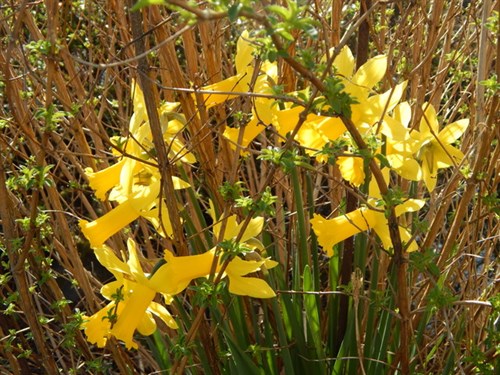
Probably the best known and most widely available is
"Jet Fire"
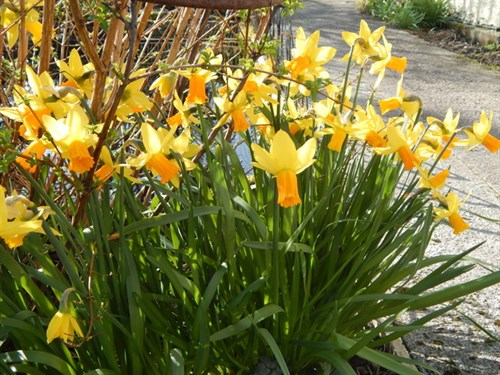
And this little cracker is "Rapture" the neaest to
the species cyclamineus - short and with tightly swept back
perianth
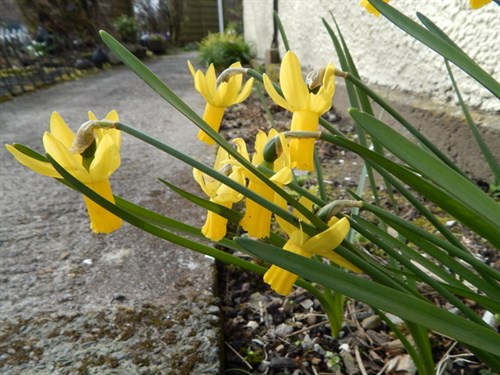
"Little Witch" is a long establshed
cultivar. A small bicolour looking as good from the back as
the front
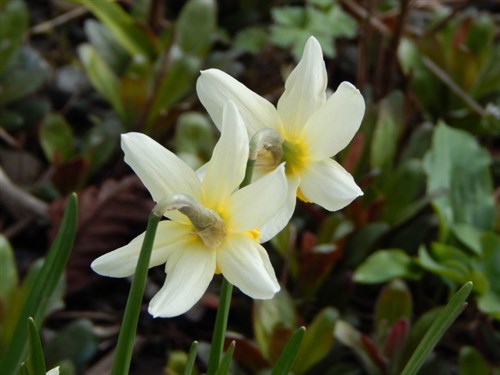
But nothing looks as good as the wild pseudonarcissus
(n.Lobularis) shown here in an orchard of a gardening friend
in Cardiganshire
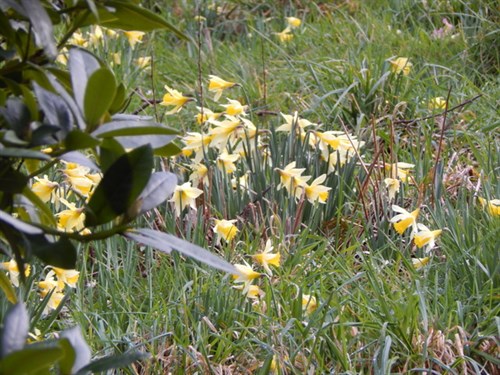
Such a beauty with flower and glaucous leaves in
perfect harmony
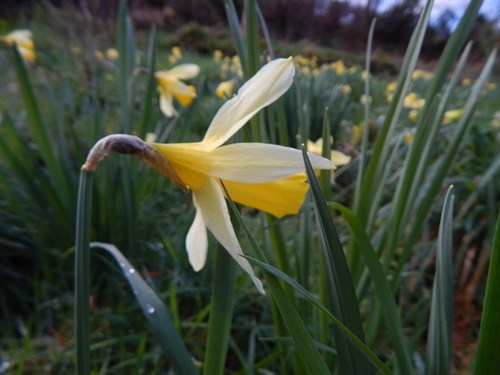
Winter flowering heathers are no longer as fashionable as they
were between the 1950's and 1980's when they were one of the staple
plants of most gardens, to go with conifers and rhododendrons. If
grown in a mixed border they can look very boring during summer
months and can be difficult to integrate. However find a spot where
they won't impact on summer flowering plants and they will
reward you with a terrific display of colour from January to April
depending on the variety chosen and the prevailing weather
conditions. There also heathers for summer and autumn flowering.
Apart from their uplifting colours in shades of pinks, reds,
purples and whites, they are marvellous resources of early nectar
for bees and insects. This month the few plants we do have have
been constantly covered with them. We get round their unsightly
summer presence by growing smaller flowered clematis to scramble
over them - clematis don't have to be trained over trellis or
pergolas to make an impact.
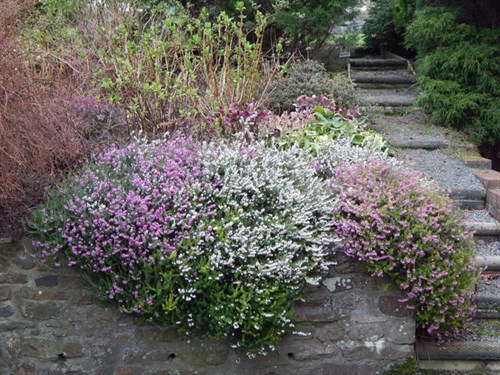
In 2005 I purchased an already reasonably sized shrub,
corylopsis pauciflora, a relative of the Chinese witch hazel,
hoping that it would soon flower. It never has done so up until
now. To be fair it had a rather severe check to its growth five
years ago when it was half eaten by a Hereford steer that had
managed to get into the garden. The shrub is now wider than it is
tall but at last it has at last flowered well with short chains of
lemon yellow, scented catkin like flowers. I believe that the
weather has been the main reason why it has flowered this year with
plenty of rain which they like and no penetrating frosts to damage
the flower buds which start to form early in the new year. There
are better forms with longer, later flowers but this one will do
fine if it continues to flower like this every year.
Corylopsis pauciflora
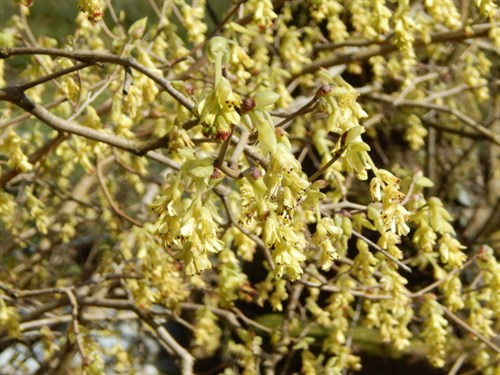
There are lots of buds on the clematis in the Atragene Group
comprising spring stalwarts such as cultivars of the alpinas,
macropetalas and Koreanas, which come into flower throughout the
Spring in that order. There are a few flowers on some alpinas, the
vast majority of which I grew from seed from the Britsh Clematis
Society - a fun way to get new plants but it can often take up to 5
years to flower them.
Clematis alpina from seed sown in
2009
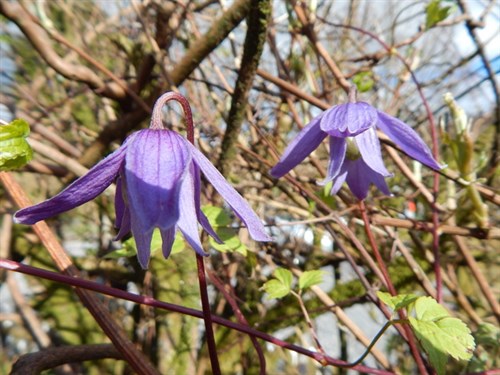
Even slower than clematis in the race from seed to flower is the
giant Himalayan lily, cardiocrinum giganteum. which can take 7
years or more to flower whereupon it dies! Challenges like this
cannot be ignored so in 2008 I sowed some seed whch germinated a
year later and we now have 12 plants in the shady Paddock Garden
borders which have formed large bulbs looking fat enougn to flower,
perhaps this year. I may be a little premature of course but I
can't wait to see them flower as none of us are getting any
younger!!. Sometimes exceeding 10 feet they make a tremendous
impact with huge, scented, downward facing trumpets. There is an
iconic picture of my gardening hero Gertrude Jekyll standing
by one in flower at Munstead Wood, her home in Surrey, dwarfed by
its magnificence. and I look forward to a similar picture soon.
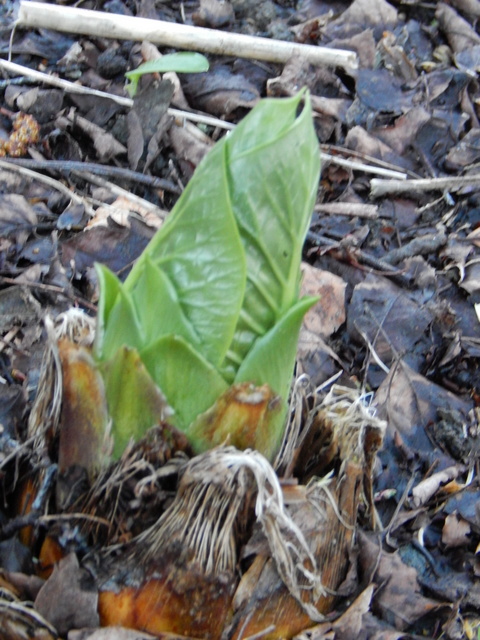
Finally a genus that is looking marvellous right now are various
forms of euphorbias the best of which are shown below. What a month
- sap (including mine) is going into overload!!
Euphorbia myrsinites low growing and wide spreading is
one of the first into flower
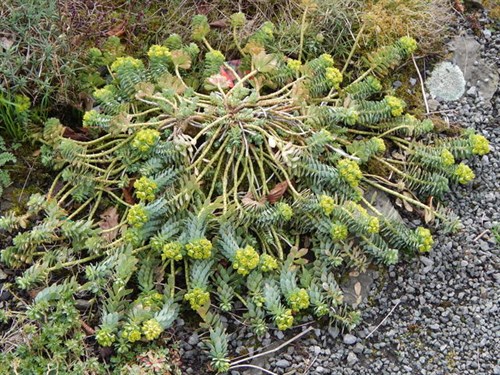
At the other end of the scale is E. characias
grown from seed which gets to its full size of nearly 6 feet
within 5 years from seed
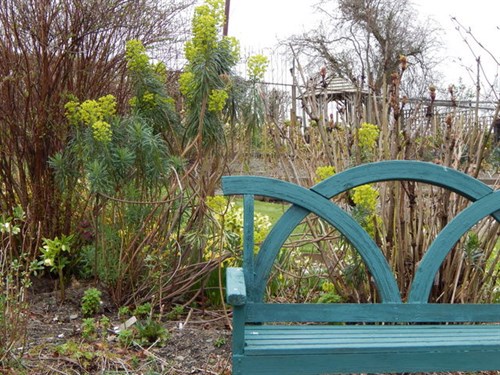
Two more suitable for smaller gardens are on the
left E. "Silver Swan" an excellent variegated form for a dry
sheltered spot making abot 2ft in time. On the right is e.
amagloides "Purprea" ideal for shade and a moiture retentive
soil.
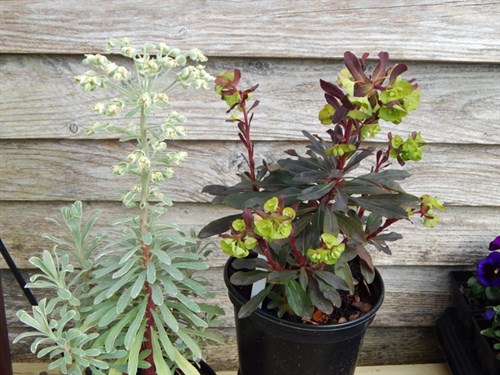
Wildlife and countryside
Apart from lambs everywhere it has been a relatively uneventful
month. The frog spawn has hatched and the water gets "blacker" by
the day as the tadpoles begin to grow, but there are far fewer than
last year. The toads have arrived recently. They are always a few
weeks later than the frogs and again their numbers are rather
limited. It is difficult to see toad spawn because it is laid in
long strings on aquatic plants. They are being spoiled this year
because there is huge amounts of blanketweed on the Paddock Pond, a
legacy of the warm sunshine.
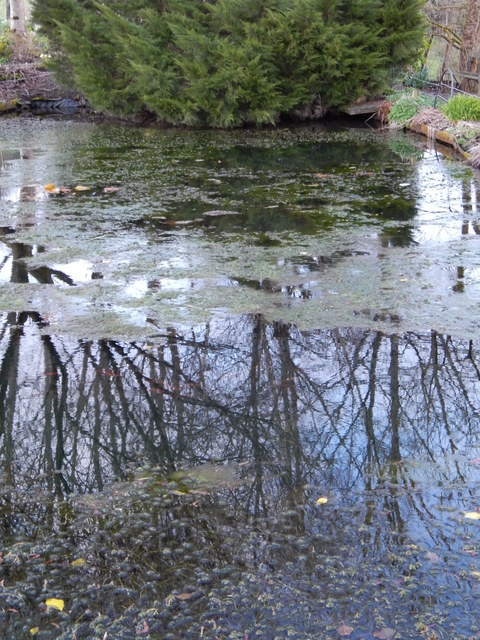
The golden rudd in the Paddock Pond are starting to show well
and taking a little dried food as are the fish in the 2 ornamental
ponds. There is a mystery however in the Pddock Pond. When I
introduced the rudd in 2011 I also stocked 50 small mirror carp
which were very showy to start with regularly taking food on the
surface . Less so in 2012 since when we have not seen them at all.
I know that carp have a preference for living most of the time in
mud at the bottom of the pond but you would have thought that there
would be occasional sightings. Even on late night patrols with the
powerful LCD lamp I see no signs of them. If they had been
predated as the rudd sometimes are by otters there would have been
tell tale remains on the bank which is where they seem to prefer to
eat thir prey. Incidentally one amazing fact came to light on my
late night forays with the lamp - dragonfly larvae are incredibly
fast swimmers with eyes that glow brightly in the beam rather like
squid but not so nice to eat!
It is good to have lighter evenings to extend our working day
and also to hear birdsong from dawn to dusk on the warmer days. No
sign of any summer visitors yet however - the first arrivals
usually being the pied flycatchers. I will have to be quick because
the bird box in the big alder by the pond, they have used for the
last few years, was completely destroyed in the gales so I need to
get the new one up a.s.a.p. Currently job no 252 on an ever growing
list!
Finally a little teaser for you. What am I holding in my hands
in the picture? No not an early Easter egg or a rugby ball,
so what is it? One clue - it is a light as a natural sponge which
it closely resembles. Answers at the end of this News Item
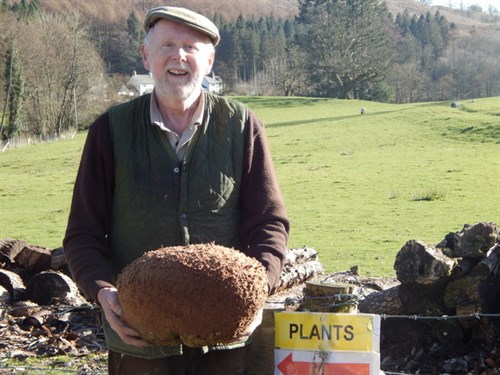
Visits
We have hardly been out and about this month because of all the
pressing tasks at home but three talks to clubs were a welcome
escape. Topics were varied with "Hostas" getting a very rare outing
for Llanwrtyd Wells Gardening Club. Thanks to them for choosing it
and also to Penllergaer and Kidwelly Clubs for a warm welcome and 2
great audiences.
Next month we have 5 talks to finish off our season, including
our long awaited trip to The Hardy Plant Society's Dorset Group in
Wimborne - 150 miles away, the furthest we have ever travelled for
a talk. Aside from the occasional rank amateur like me, Hardy Plant
Society Groups can be relied on to have a range of top flight
speakers and it is a privilege to be squeezed in between Chris
Beardshaw this month and Timothy Walker curator of Oxford
University Botanic Garden in May. No pressure then!! Really looking
forward to it and meeting up with members who visited Cilgwyn last
July
Dylan Thomas Centenary Year
Today on one of our monthly trips to Swansea 35 mile away,I
thought it was about time to revisit some of the childhood haunts
of Dylan Thomas whose centenary year is being celebrated in the
city of his birth, as it is in all other parts of the world
where his poetry and prose are held in great affection. The
pictures below supported by some of his magical words, convey the
feeling of place that shines through all his work, wherever that
place happens to be.
Dylan's home at 5 Cwmdonkin Drive and upstairs the
front bedroom where he was born. Now restored by the current owners
and open to the public.

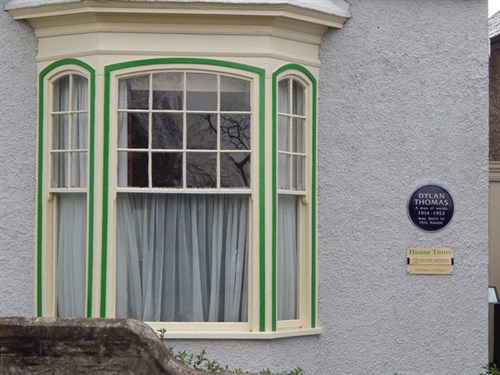
Cwmdonkin Park "that grew up with me; that
small interior world widened as I learned its names and
boundaries"
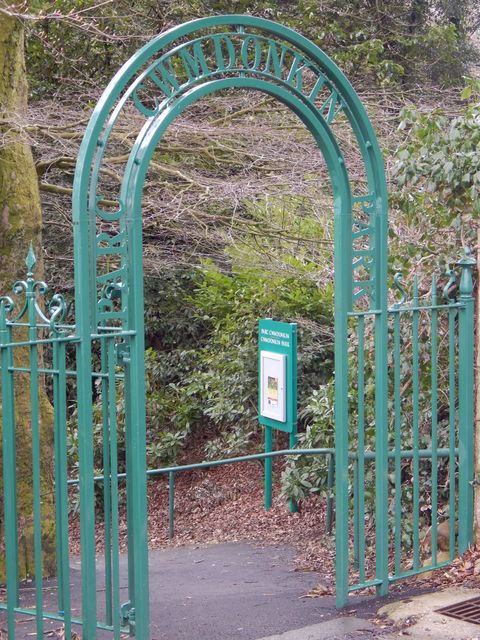
"the trees of the everlasting park, where a brass
band shakes the leaves and sends them showering down on the nurses
and the children,the cripples and the idlers and the
gardeners"
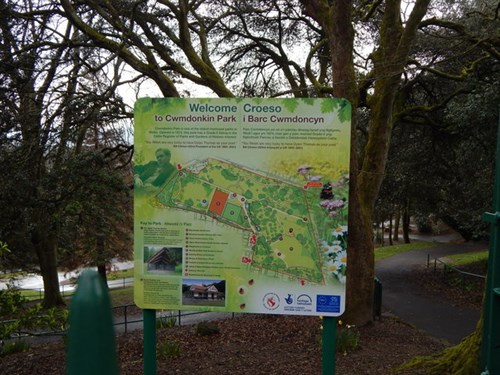
" ...a world of rockery, gravel path, playbank,
bowling green, bandstands, reservoir, dahlia garden.. " - all still
there making it a very special place of pilgrimage.
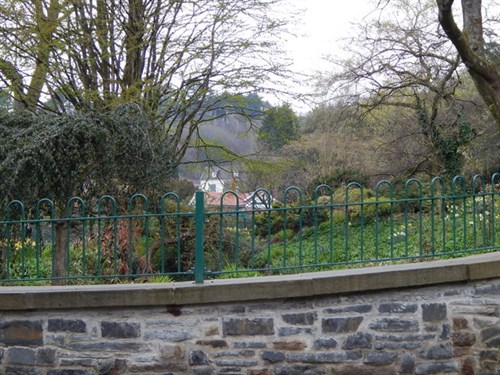
There are references to Dylan wherever you look in
the park.
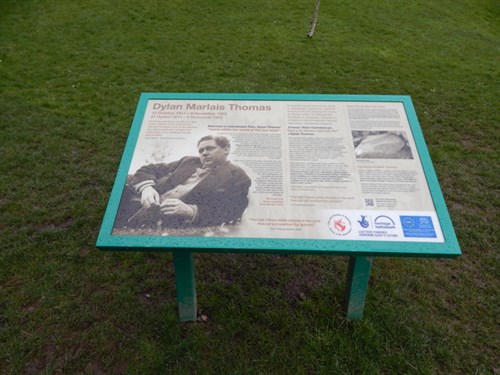
"The hunchback in the park, A solitary mister Propped
between trees and water From opening of the garden lock That lets
trees and water enter Until the Sunday sombre bell at
dark.
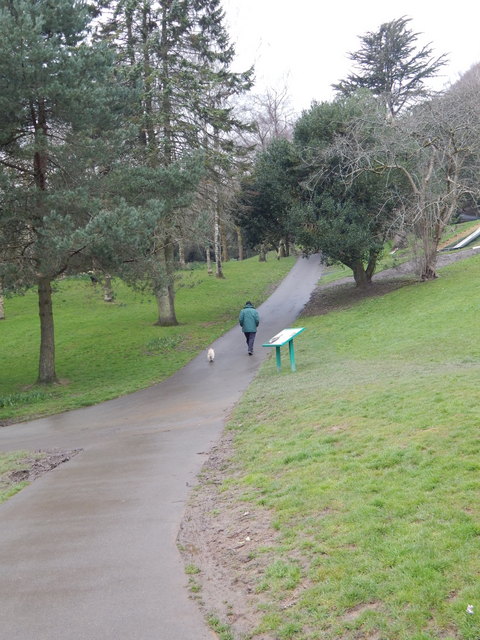
The view from Cwmdonkin, "over the trees and
chimneys of my ugly, lovely town"..." across the Devon facing
seashore".. " and the mumbling bay". "The memories of childhood
have no order and no end"
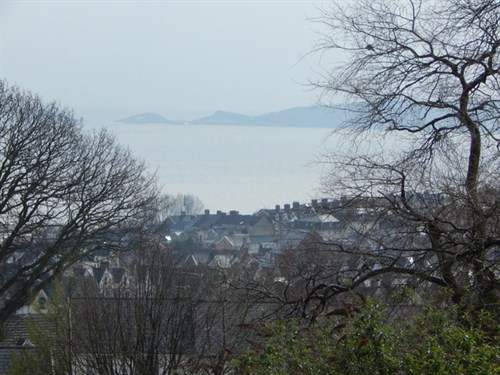
To discover more about Dylan and how to visit his birthplace and
other landmarks go to www.5cwmdonkindrive.com
and www.dylanthomas.com
Finally the answer to the little teaser I posed earlier on and
well done if you got it right. It is the spent remains of the giant
puffball I featured in the the August News 2013. (And in that
article I was clearly wrong to suggest that when the spores form
the puffball quickly deflates; it is part of the never ending
fascination and education of watching and learning from nature). It
has been blown well away from where I photographed it so being full
of spores will there be giant puffballs all over the field this
autumn? Watch this space.
Happy gardening and enjoy Spring, probably the best time of the
year.